The future of energy in Scotland: Scottish energy strategy
Scotland's first energy strategy sets out the Scottish Government’s vision for the future energy system in Scotland.
Chapter 4. Scotland's Economic Opportunity
The energy sector is the cornerstone of Scotland's modern, industrialised economy. It delivers reliable and secure energy to our homes and businesses, supports tens of thousands of jobs and generated £45.7 billion in turnover for Scotland in 2015 [31] .
Value of the Energy Sector to the Scottish Economy
Oil and Gas [32]
- Scotland is estimated to be the largest oil producer and second largest gas producer in the EU on an internationally comparable basis.
- 2000+ companies supporting circa 115,000 Scottish oil and gas supply chain jobs in 2017.
- Oil and gas production estimated to be worth £17.5 billion to the Scottish economy in 2016/17.
- £8 billion of capital investment committed to oil and gas production from beneath Scottish waters in 2016/17.
Renewables & Low Carbon Technologies [33]
- An estimated 58,500 jobs supported by Scotland's low carbon and renewable energy sector and supply chain in 2015.
- The Scottish low carbon and renewable energy sector and supply chain generated a turnover of £10.5 billion in 2015, accounting for 13.5% of the total UK turnover in this sector.
- £910million was invested in Scottish renewable generation assets in 2015.
- Scotland's low carbon and renewable energy sector generated £224.5 million of exports in 2015.
Building on Scotland's Energy Strengths
Scotland has a well-established oil and gas sector and a proud engineering heritage. We also have enviable natural resources, which have provided the platform for the recent growth in renewable energy deployment.
Building on these strengths will help us deliver our goal of a modern, integrated, low carbon energy system, and support the delivery of the ambitions and priorities set out in Scotland's Economic Strategy ( SES) [34] .
Supporting continued investment in oil and gas exploration and production, and in renewable and low carbon solutions, will provide Scotland with the energy system we need for the 21st century. Energy research expertise and innovation in renewables and local energy systems will help our transition to a low carbon, sustainable economy.
Scotland's rich energy history and expertise will support greater internationalisation by strengthening our renewable supply chains and research dissemination. All of these actions will work towards our overarching aim of producing inclusive growth, with the benefits of this Strategy felt across a wide range of places and people in Scotland.
The Scottish Government is committed to building on Scotland's international reputation for excellence in energy, and to forging collaborative partnerships with other countries.
This Strategy is consistent with the key outcomes and ambitions of the Scottish Government's International Policy Statement [35] and Framework [36] , which highlights 'Energy' as an area through which we can enhance Scotland's global outlook.
Hywind Scotland Pilot Park construction (Credit: Roar Lindefjeld, Statoil)
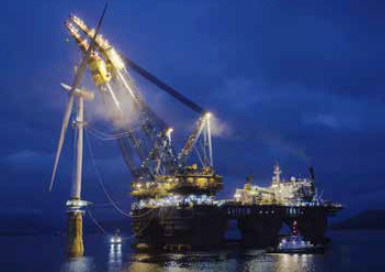
Decommissioning of Buchan Alpha oil production vessel at Dales Voe, Lerwick Harbour (Credit: Highlands and Islands Enterprise)
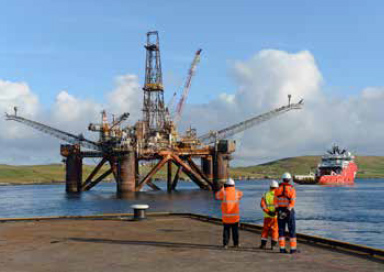
Great Glen House, Inverness – The first BREEAM 'Excellent' office in the UK (Credit: Scottish Natural Heritage)
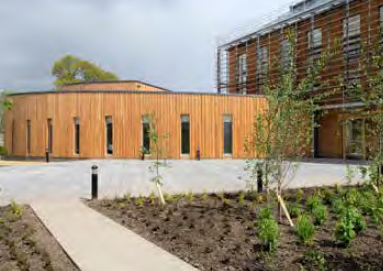
Oil and Gas
Scotland remains at the forefront of the worldwide oil and gas industry. Half a century of North Sea oil and gas exploration and production has created a hugely valuable Scottish industry, with internationally-renowned offshore engineering expertise. Our world leading supply chain now trades with over 100 countries.
In particular, Scottish expertise and skills in subsea engineering are globally renowned – and are regularly used in other sectors, such as marine and defence.
Our commitment to helping maximise economic recovery from the North Sea will maintain Scotland's energy security throughout the energy transition. It will also mean our energy companies retaining the capabilities that will help them take advantage of future supply chain opportunities at home and allow further internationalisation within this sector.
Decommissioning
As the North Sea is a relatively mature basin, decommissioning on a significant scale will commence earlier than other basins – meaning that Scottish supply chain companies have the opportunity to build on their success and develop expertise which can then be exported.
The latest forecasts suggest that decommissioning in the UK Continental Shelf could be worth around £60 billion over the coming decades, with a forecast spend of nearly £17 billion in the next 8 years alone [37] .
Nuclear decommissioning also represents huge opportunity for Scotland. There are more than 400 civil nuclear reactors across the world due to decommission [38] . Over 50 Scottish companies are already operating within the nuclear decommissioning supply chain, and doing so with a competitive advantage through their experience and involvement at Dounreay.
Renewable and Low Carbon Solutions
Renewable and low carbon solutions can enable new or emerging sectors to develop products and services for use in Scotland and around the world.
Analysis by the International Finance Corporation indicates that the Paris Agreement will help open up $23 trillion worth of opportunities for climate-smart investments in emerging markets between 2016 and 2030.
This is an area where Scotland has a history of innovation, where high investment is expected and where Scottish companies will be well placed to develop deeper ties with their international trading partners. The move to renewable and low carbon solutions is central to our ambitions of producing sustainable, inclusive growth.
Offshore Renewables
The offshore wind sector expects to invest up to £210 billion between 2016 and 2025, primarily in Europe [39] . This presents tremendous opportunities for the Scottish supply chain and manufacturers, building on Scotland's oil and gas expertise and experience, as well as major investment in port and harbour infrastructure.
Our reputation for innovation, as hosts to the Offshore Renewable Energy Catapult and the world's first floating offshore wind farm, also places Scotland on a strong footing.
Workers in front of an AR1500 turbine, used in the world's flagship tidal stream project, MeyGen, in Scotland's Pentland Firth (Credit: Highlands and Islands Enterprise)
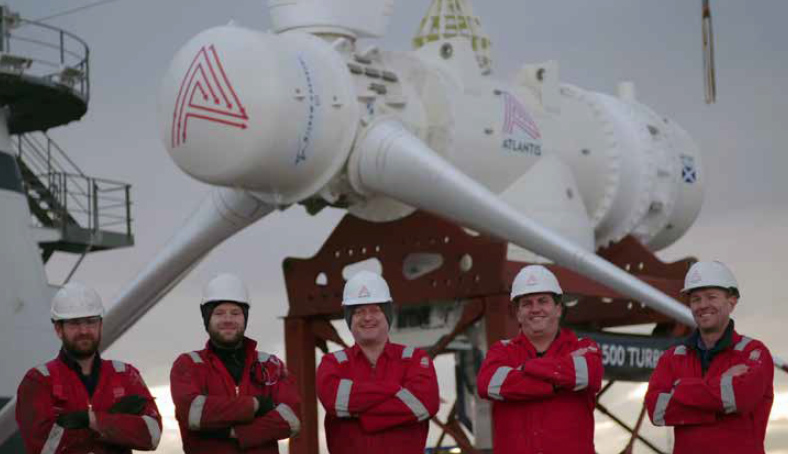
Scotland's outstanding natural resources, and our decades of offshore engineering experience, make us a hugely attractive prospect for marine renewables. The Scottish Government has done more than any other nation to support the development of these technologies.
Orkney hosts not only the world's first grid-connected wave and tidal test centre (the European Marine Energy Centre) but also the world's largest tidal turbine (ScotRenewables), whilst the Pentland Firth is home to the world's largest planned tidal stream array (MeyGen).
Onshore Wind
Onshore wind is another key component of the big industrial opportunity that renewables create for Scotland. The sector supports an estimated 7,500 jobs in Scotland, generating more than £3 billion in turnover in 2015 [40] .
Our businesses have developed real strengths across the whole supply chain – in project development, civil engineering, and operation and maintenance. Campbeltown is also currently home to the UK's only wind turbine tower fabricator.
Energy Efficiency
Scotland's capabilities in architecture and design provide a natural advantage in the low carbon buildings sector. Scotland's Energy Efficiency Programme offers a huge opportunity for construction and energy systems technologies companies, with low carbon building technology sales in Scotland forecast to be worth £1.9 billion by 2020 [41] .
Emerging Energy Opportunities
The areas explored above constitute a huge prize for Scotland. But there are other opportunities which we are well placed to exploit.
Our economic development agencies have several programmes and partnerships in place to support energy innovation. These have led to major investments, designed to support key infrastructure projects and companies, and to help Scotland exploit these emerging opportunities.
Energy System Technologies supporting Innovative Local Energy Systems
Energy System Technologies ( ESTs) span the management, transfer, storage and transformation of energy. Global spend on ESTs could amount to around £70 billion between 2018 and 2020, with about half occurring in Europe, presenting opportunities for Scottish companies to gain a foothold in this market.
Scotland has strengths in knowledge provision, digital platforms, sensors, controls and security, engineering services and power electronics. We also host facilities such as the Power Networks Demonstration Centre ( PNDC) – a world-class establishment, designed to accelerate the adoption of new, smart technologies within advanced power grids.
The shift to smart, flexible networks, already underway, will also demand and depend upon the continuing development of systems and technologies which can store power and help to manage increasingly decentralised electricity grids.
Scotland is already developing local energy solutions, in line with the Scottish Government's place-based approach to inclusive growth. These are mainly in Island communities and other rural areas, with innovative methods of energy storage helping to manage grid constraints.
Surf 'n' Turf hydrogen electrolyser, Orkney (Credit: Colin Keldie)
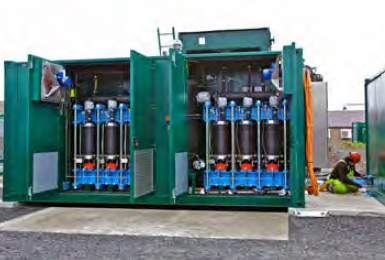
Aberdeen hydrogen bus project (Credit: Transport Scotland)

The DART® simulation suite at Robert Gordon University (Credit: Scottish Enterprise)

Our Low Carbon Infrastructure Transition Programme can help demonstrate and improve innovative local energy systems, creating an opportunity for Scotland to lead in developing, deploying and exporting these solutions. Scotland's development agencies will continue to support companies working and innovating in this field.
Carbon Capture and Storage and Carbon Capture and Utilisation
Carbon capture and storage ( CCS) in depleted North Sea oil and gas reservoirs could be hugely important to our energy future, with opportunities to repurpose infrastructure and draw on Scotland's extensive expertise in the offshore sector.
Carbon capture and utilisation ( CCU) refers to the reuse of CO 2 captured from industrial processes or power generation to create premium chemical products. This has been identified as an increasingly important market for Scotland's chemical industry. When coupled with green hydrogen, this could include the manufacture of renewable transport fuels.
Both opportunities would use existing Scottish supply chain strengths in chemicals and oil and gas.
Low Carbon Transport
The turnover for Scottish companies involved in the transport sector is around £2 billion per annum [42] . Our target to phase out the need for new petrol and diesel vehicles by 2032 creates a raft of new opportunities for these companies.
We want to help maximise Scottish content in the UK vehicle supply chain, which manufactures 1.8 million vehicles and 2.5 million engines per annum.
There are also opportunities to develop niche transport applications in Scotland's rural and island communities – given Scotland's existing bus and ferry manufacturing capability, hydrogen's compatibility as a fuel for these heavy duty cycle vehicles, and because the refuelling infrastructure is greatly simplified as the vehicles operate constrained routes.
Digital Energy
Digital technologies and skills will continue to transform and disrupt markets, with new, data-driven business models and platforms based on a better-improved understanding of customer and market behaviour. The growth of innovative local energy systems presents an opportunity for Scottish businesses to develop new ways to trade energy.
Scotland has rich potential in these areas, with a growing digital economy and particular capabilities in areas such as data science and informatics. We have around 150 businesses delivering value from data and employing over 5,500 people.
We believe that Scottish technology developers and businesses are well equipped to deliver the software, systems and innovations that smarter homes, appliances, vehicles and networks will demand. All these innovations have significant export potential.
Hydrogen/Fuel Cells
Scotland already has several hydrogen projects. The hydrogen buses in Aberdeen, hydrogen refuse trucks in Fife, and the Surf 'n' Turf hydrogen project in Orkney, have all attracted international interest.
Our natural resources, and our geography, mean that fuel cell buses and ferries have great potential. Fuel cells can also help provide backup or prime power, particularly in remote areas.
A range of industrial applications for hydrogen are in use or emerging that could help displace high carbon inputs to production processes, including in the manufacture of fertilisers and petrochemicals, and in refining and steel production. These applications have the potential to improve energy productivity whilst enhancing approaches to the circular economy.
Scotland's considerable renewable generation capacity could be used to produce hydrogen, or ammonia, and help balance networks, support local energy models, and decarbonise our heat and transport systems. International markets are also emerging as demand grows for flexible energy system technologies.
There is also potential for other forms of fuel cell, for example, a hybrid combined heat, power and cooling fuel cell is being installed at the new Aberdeen Exhibition and Conference Centre, which uses a combination of mains gas, grid electricity and biomethane.
Realising the Economic Opportunity
We intend to continue the work that we have been doing with businesses in Scotland – helping them use their experience, adaptability and willingness to diversify in order to become more competitive, and to deliver sustainable, inclusive, economic growth.
We can increase growth and competitiveness across the energy sector by developing leadership and entrepreneurial capability – equipping companies to manage change, realise opportunities and increase productivity.
The newly established Enterprise and Skills Strategic Board will improve this capability by co-ordinating the activities of Scotland's enterprise and skills agencies (Scottish Enterprise, Highlands and Islands Enterprise, Skills Development Scotland and the Scottish Funding Council).
Stimulating Investment
The Scottish Government and its partners have used initiatives such as LCITP, REIF and others to attract and stimulate interest and private sector investment across a range of renewable energy projects and companies, including at community level.
Our £500 million Scottish Growth Scheme will target high-growth, innovative and export-focused small and medium-sized enterprises ( SMEs). It aims to stimulate more than £200 million of investment to help businesses grow via the Scottish-European Growth Co-Investment Programme and the SME Holding Fund – which, alongside additional private sector investment, we expect to provide over £100 million to innovative, high-growth companies.
The establishment of a Scottish National Investment Bank, announced in the recent Programme for Government, will provide an important resource for the Scottish economy. The Bank will be a key partner for Government and business, through the provision of patient long-term capital, supporting our Economic Strategy and this Energy Strategy.
The Bank will provide and catalyse investment – creating opportunities for Scotland, increasing innovation and accelerating the transformation to a low carbon, high-tech, connected, globally-competitive and inclusive economy.
Supporting Research and Innovation
Research and innovation are fundamental drivers of sustainable growth and long-term competitiveness, and lie at the heart of Scotland's Economic Strategy.
In Scotland, we have world-class research and innovation strengths, with facilities such as the Oil & Gas Technology Centre, European Marine Energy Centre, Edinburgh Centre for Carbon Innovation, the National HVDC Centre, and the Power Network Demonstration Centre.
The Scottish Government, along with the Scottish Funding Council, currently supports the Energy Technology Partnership ( ETP.) This is the largest power and energy research partnership in Europe, and supports R&D capability across a range of technologies. The ETP has recently begun a new programme to support the recruitment of PhD students undertaking research related directly to the key themes within this Strategy.
We will continue to support the work of these and other centres and innovators – in particular those operating at UK and European levels such as the UK Energy Research Centre ( UKERC), the Energy Systems Catapult, the National Centre for Energy System Integration, the International Energy Agency and the International Renewable Energy Research Agency. Their continuing success in analysing whole energy system change, and proving and scaling new technologies and processes can help reduce energy costs and provide huge commercial opportunities.
We will also support research and development activity within businesses – for example by increasing Scottish Government funding for new business research and development projects by 70%, with an additional £45 million to be invested over the next three years.
Strengthening Supply Chains
Scottish businesses have developed real strengths across the whole energy supply chain, including in project development, civil engineering, and operation and maintenance.
Renewable power delivers so many benefits for Scotland, none more so than the economic and industrial potential. Scottish yards and docks, new and established businesses, manufacturers and suppliers, engineers and innovators. From the production and assembly of huge towers and jackets, to the installation and maintenance of community and household developments, Scottish yards and docks, new and established businesses, manufacturers and suppliers, engineers and innovators, have grown into the renewables opportunity.
We are determined to continue to harness this potential – to support as much Scottish industrial, developmental, innovation and supply chain activity as possible as we continue to exploit the onshore and offshore renewables potential that will power all of our futures.
The Scottish Government will pursue activities with developers which will secure the full benefits of the low carbon transition and establish economic activity here. We will do this through the full suite of powers at our disposal.
Creating New Business Models
Digital technologies and techniques – such as the capture and application of "big data" to create or improve products and services – are already transforming sectors across the economy.
This is happening in the energy sector too, reflected by the move from passive to more active energy systems and consumers. For example, heating systems which respond to a user's location or remote commands, or smart devices which can operate when demand and prices are low.
Scotland's Digital Strategy [43] sets out our determination to anticipate and react, in an agile way, to the ever-changing opportunities of the digital age.
Our Circular Economy Strategy [44] maps out opportunities and actions to reduce unnecessary waste in the energy system, and across the wider Scottish economy. The circular economy approach is already having an effect in the manufacturing sector, with more thought given to the use and re-use of materials in manufacturing processes.
Developing Necessary Skills
Scotland already has many of the skills in engineering, construction, information technology and chemical science, that will speed our transition to a low carbon energy system. Our research and postgraduate education remains world leading.
Skills Development Scotland ( SDS) works extensively with employers, colleges, universities and other partners to develop new work-based learning frameworks, and to match initiatives and investment with future demand.
We are determined to maintain a pipeline of suitably-skilled people. We will do this by working collaboratively, through a responsive system that can anticipate future skills needs, and the opportunities and challenges which new technologies and business models present.
Our STEM Education and Training Strategy [45] offers a comprehensive plan designed to improve science, technology, engineering and mathematics across the education and training landscape. It will ensure that more young people have access to inspiring science events and activities through Scotland's science centres and festivals. We will also develop a Scottish Young STEM Leaders programme to grow and spread inspiration and enthusiasm for STEM, starting in the early years.
Boosting Inclusive Growth
Inclusive growth is our highest strategic priority. This means helping establish businesses, workplaces, workforces and places which are fairer and more creative in their growth and development.
This Strategy, with its focus on improving energy efficiency and consumer engagement and protection, seeks to address inequalities that are exacerbated by high energy prices and barriers to improved market access for certain vulnerable groups in society.
The Scottish Government supports a holistic energy system, where treating consumers fairly is viewed as an important economic outcome for businesses and society alike. Empowered consumers, acting within a system of fair competition, support inclusive and sustainable growth in our economy, enabling businesses to innovate and grow in response to consumer need. This also creates an environment where businesses can have confidence that doing the right thing will be rewarded, and that unlawful or poor business practices will be tackled.
Inclusive growth, particularly in our most fragile rural areas, depends on strong communities and on creating the conditions for successful businesses to thrive.
Community-owned renewables projects generate income, which communities can re-invest. This has the potential to create jobs, deliver local services and increase population as a result. Increasing the level of shared ownership of energy projects can play a big role in this process.
As our energy system changes, the jobs market will change too. Energy employment may become more spread out across Scotland rather than concentrated in areas where major energy producers or power plants are located.
Low carbon investments may therefore provide an opportunity for more balanced regional development within Scotland. Smaller businesses across Scotland – and in particular those in rural locations – will benefit from engaging in growing markets for local energy systems, renewable energy, energy efficiency and low carbon heat and transport solutions.
Cultivating Regional Partnerships
The creation of new Regional Economic Partnerships, delivering city-region and regional growth deals across Scotland, will be a key driver of inclusive growth, taking cognisance of the variety of natural assets across the country.
Regional Economic Partnerships bring together local authorities, enterprise agencies, the private sector and education and skills providers to create coherent regional economic strategies and plans.
This means harnessing all of our natural, and human, resources at the regional level. Using Regional Economic Partnerships to align national and local priorities, and to maximise the impact of public resources through combining with private sector investment, can multiply the value of energy projects to communities.
Supporting Internationalisation
Scotland's energy companies are already highly successful in the international marketplace, with Scottish energy exports worth £16 billion in 2015.
Strengthening our focus on overseas opportunities can help attract new investment into Scotland, creating more opportunities to strengthen our renewable energy supply chain.
We are establishing a network of Trade Envoys to champion Scotland's export interests and strengthen our market intelligence capacity. We are adding to our Innovation and Investment Hubs in London and Dublin by establishing hubs in Berlin and Paris, maximising opportunities in France and Germany, while developing our existing presence in Brussels into a hub.
Our enterprise agencies will work with more companies than ever, helping them to export more of their products and services. For example, Scottish Enterprise and the Nippon Foundation in Japan will work together to invest in collaborative research and development projects related to subsea technology and innovation challenges. Scottish companies will apply their knowledge and expertise of the marine environment through a series of technology calls. Scottish Enterprise is working closely with Subsea UK and others to help deliver these calls, the first of which was announced in December 2017.
In addition, we have an opportunity to secure and exploit a position of global leadership for Scotland in relation to smart local energy systems. The Sustainable Islands International programme is a major new three year programme launched by the enterprise agencies and Scottish Development International. It will support companies working together to identify opportunities in international markets, and to develop innovative solutions to reduce carbon emissions, increase energy security and reduce costs to consumers.
Contact
There is a problem
Thanks for your feedback